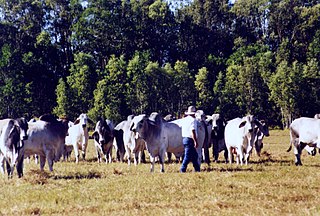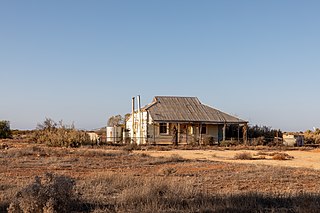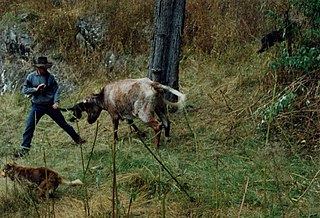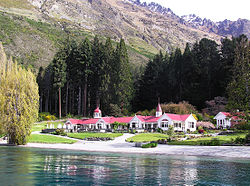
In Australia, a station is a large landholding used for producing livestock, predominantly cattle or sheep, that needs an extensive range of grazing land. The owner of a station is called a pastoralist or a grazier, corresponding to the North American term "rancher".

Sheep farming or sheep husbandry is the raising and breeding of domestic sheep. It is a branch of animal husbandry. Sheep are raised principally for their meat, milk, and fiber (wool). They also yield sheepskin and parchment.

In Australia, a stockman is a person who looks after the livestock on a station, traditionally on horse. It has a similar meaning to "cowboy". A stockman may also be employed at an abattoir, feedlot, on a livestock export ship, or with a stock and station agency.

In Australia and New Zealand, a cattle station is a large farm, the main activity of which is the rearing of cattle. The owner of a cattle station is called a grazier. The largest cattle station in the world is Anna Creek Station in South Australia, which covers an area of 23,677 square kilometres.

Rawlinna is an isolated locality on the Trans-Australian Railway in Western Australia, about 900 kilometres east of Perth and 350 kilometres west of the Western Australia / South Australia border. It is on the Nullarbor Plain, about 50 kilometres from its western fringe; the topography is flat and well grassed, with saltbush and bluebush, with small belts of myall and myoporum trees. Annual rainfall is 288 millimetres. Maximum daytime temperatures are typically 38 °C (100 °F) through summer and 19 °C (66 °F) during winter. In 2016, the population in the area was recorded as 30 people.

A muster (Au/NZ) or a roundup (US/Ca) is the process of gathering livestock. Musters usually involve cattle, sheep or horses, but may also include goats, camels, buffalo or other animals. Mustering may be conducted for a variety of reasons including routine livestock health checks and treatments, branding, shearing, lamb marking, sale, feeding and transport or droving to another location. Mustering is a long, difficult and sometimes dangerous job, especially on the vast Australian cattle stations of the Top End, 'The Falls' (gorge) country of the Great Dividing Range and the ranches of the western United States. The group of animals gathered in a muster is referred to as a "mob" in Australia and a "herd" in North America.
Boolardy Station is a remote former sheep and cattle station in the Mid West (Murchison) region of Western Australia, about 194 km (121 mi) north-north-east of Pindar and 200 km (120 mi) west-south-west of Meekatharra. It is within the Shire of Murchison and situated on pastoral lease no. 3114/406. The area of the lease is 3,467.48 square kilometres (1,338.80 sq mi).

The raising of domestic sheep has occurred in nearly every inhabited part of the globe, and the variations in cultures and languages which have kept sheep has produced a vast lexicon of unique terminology used to describe sheep husbandry.
De Grey Station is a pastoral lease, formerly a sheep station and now a cattle station, approximately 80 kilometres (50 mi) east of Port Hedland on the mouth of the De Grey River in the Pilbara region of Western Australia.
Credo is a former pastoral lease located about 70 kilometres (43 mi) north of Coolgardie in the Goldfields of Western Australia.
Cogla Downs Station is a pastoral lease and sheep station located in the Mid West region of Western Australia.

Rawlinna Station is a pastoral lease and sheep station located about 339 kilometres (211 mi) east of Kambalda in the Goldfields-Esperance region of Western Australia. The locality of Rawlinna and the Trans-Australian Railway are situated along the boundary of the station. It is the largest sheep station in Australia.
Arubiddy Station is a pastoral lease that operates as a sheep station in Western Australia.
Minilya Station, most often referred to as Minilya, is a pastoral lease currently operating as a cattle station that once operated as a sheep station in the Gascoyne region of Western Australia.
Beringarra Station, most commonly referred to as Beringarra, is a pastoral lease that once operated as a sheep station but is currently operating as a cattle station in Western Australia.
Balgair or Balgair Station is a pastoral lease, currently operating as a cattle station and previously as a sheep station. It is located about 25 kilometres (16 mi) west of Rawlinna and 374 kilometres (232 mi) east of Kambalda on the Nullarbor Plain in the Goldfields of Western Australia. The surface land system is described as a "deflated limestone plain" that has severe erosion in parts. Balgair is bordered to the south by Arubiddy Station and also shares a border with vacant crown land.
Wyloo Station, often referred to as Wyloo and previously known as Peake, is a pastoral lease that operates as a sheep station and cattle station.
Jumbuck Pastoral Company is an Australian company that operates numerous cattle stations and sheep stations in Western Australia, South Australia and the Northern Territory

Parakylia Station is a pastoral lease that once operated as a sheep station but now operates as a cattle station in outback South Australia.
Barwidgee Station is a pastoral lease that operates as a sheep station in Western Australia.












